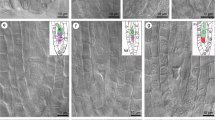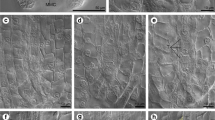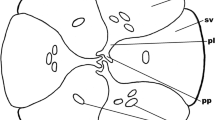Abstract
In this study, we investigated cytohistochemistry, cycle progression, and relative DNA content of the female gametophyte cells of Helleborus bocconei Ten. before and after fertilization process. The early stages of embryo development were also investigated. H. bocconei possesses a monosporic seven-celled/eight-nucleate Polygonum type female gametophyte, characterized by a morpho-functional polarity. The cells of the embryo sac showed abundant reserves of polysaccharides, strongly increasing in the egg cell just before fertilization. With different timing in DNA replication during cell cycle progression, synergids, egg cells, and polar nuclei showed a haploid DNA content at the end of their differentiation, while antipodes underwent three DNA endoreduplication cycles. Programmed cell death symptoms were detectable in synergid and antipodal cells. After double fertilization, the central cell quickly underwent many mitotic cycles forming the endosperm, which exhibited a progressive increase in protein bodies and starch grains. Close to the develo** embryo, the endosperm differentiated a well-defined region rich in a fibrillar carbohydrate matrix. The zygote, that does not start immediately to divide after double fertilization, developed in to an embryo that reached the heart stage at fruit maturation time. A weakly differentiated embryo at this time indicates a morpho-physiological dormancy of seeds, as a survival strategy imposed by the life cycle of this plant with seed dispersal in spring and their germination in the following winter.








Similar content being viewed by others
References
Amien S, Kliwer I, Marton ML, Debener T, Geiger D, Becker D, Dresselhaus T (2010) Defensin-like ZmES4 mediates pollen tube burst in maize via opening of the potassium channel KZM1. PLoS Biol 8:e1000388. doi:10.1371/journal.pbio.1000388
An LH, You RL (2004) Studies on nuclear degeneration during programmed cell death of synergid and antipodal cells in Triticum aestivum. Sex Plant Reprod 17:195–201
Aschan G, Pfanz H, Vodnik D, Batič F (2005) Photosynthetic performance of vegetative and reproductive structures of green hellebore (Helleborus viridis L. agg.). Photosynthetica 43:55–64
Atwater BR (1980) Germination, dormancy and morphology of the seeds of herbaceous ornamental plants. Seed Sci Technol 8:523–573
Bartoli G, Forino LMC, Durante M, Tagliasacchi AM (2015) A lysigenic programmed cell death-dependent process shapes schizogenously formed aerenchyma in the stems of the waterweed Egeria densa. Ann Bot 116:91–99
Baskin JM, Baskin CC (2004) A classification system for seed dormancy. Seed Sci Res 14:1–16
Briggs CL (1993) The initiation development, and removal of embryo sac wall ingrowths in the develo** seeds of Solanum nigrum L. An ultrastructural study. Ann Bot 76:429–439
Bruun L (1989) The mature embryo sac of the sugar beet, Beta vulgaris: a structural investigation. Nord J Bot 7:543–551
Bu̇žek J, Ebert I, Ruffini Castiglione M, Široký J, Vyskot B, Greilhuber J (1998) Structure and DNA methylation pattern of partially heterochromatinised endosperm nuclei in Gagea lutea (Liliaceae). Planta 204:506–514
Cecchi Fiordi A, Papini A, Brighigna L (2002) Programmed cell death of the nonfunctional megaspores in Larix leptolepis (Sieb. Et Zucc.) Gordon (Pinaceae): ultrastructural aspects. Phytomorphol 52:187–195
Coimbra S, Salema R (1999) Ultrastructure of the develo** and fertilized embryo sac of Amaranthus hypochondriacus L. Ann Bot 84:781–789
D’Amato F (1984) Role of polyploidy in reproductive organs and tissues. In: Johri BM (ed) Embryology of angiosperms. Springer, Berlin, pp 519–566
Engell K (1995) Embryo morphology of the Ranunculaceae. Plant Syst Evol 9:207–216
Erdelská O (1985) Dynamics of the development of embryo and endosperm I. (Papaver somniferum, Nicotiana tabacum, Jasione montana). Biologia 40:17–30
Fascetti S, Potenza G, Castronuovo D, Candido V (2014) Wild geophytes of ornamental interest in the native flora of southern Italy. Ital J Agron 9:99–106
Feder N, O’Brien TP (1968) Plant microtechnique: some principles and new methods. Am J Bot 55:123–142
Fisher DB (1968) Protein staining of ribboned epon sections for light microscopy. Histochemie 16:92–96
Folsom MW, Cass DD (1990) Embryo sac development in soybean: cellularization and egg apparatus expansion. Can J Bot 68:2135–2147
Gerasimova-Navashina EN (1990) Fertilization in angiospermous plants. Bot zhurn 8:1061–1071
Giorgetti L, Ruffini Castiglione M (2016) Oil palm in vitro regeneration: microdensitometric analysis during reproduction and development. Caryologia 69:5–11
Giorgetti L, Ruffini Castiglione M, Turrini A, Nuti Ronchi V, Geri C (2011) Cytogenetic and histological approach for early detection of “mantled” somaclonal variants of oil palm regenerated by somatic embryogenesis: first results on the characterization of regeneration system. Caryologia 64:223–234
Greilhuber J, Dolezel J, Lysak MA, Bennett MD (2005) The origin, evolution and proposed stabilization of the terms ’genome size’ and ’C-value’ to describe nuclear DNA contents. Ann Bot 95:255–260
Guitián J, Larrinaga AR (2014) The role of post-floral persistent perianth in Helleborus viridis subsp. occidentalis (Ranunculaceae). Nord J Bot 32:852–857
Heydlauff J, Gross-Hardt R (2014) Love is a battlefield: programmed cell death during fertilization. J Exp Bot 65:1323–1330
Higashiyama T, Yabe S, Sasaki N, Nishimura Y, Miyagishima S, Kuroiwa H, Kuroiwa T (2001) Pollen tube attraction by the synergid cell. Science 293:1480–1483
Huang BQ, Russell SD (1994) Fertilization in Nicotiana tabacum: cytoskeletal modifications in the embryo sac during synergid degeneration. A hypothesis for short-distance transport of sperm cells prior to gamete fusion. Planta 194:200–214
Jensen WA (1962) Botanical histochemistry—principles and practice. University of California, Berkeley. W. H. Freeman and Company
Kapil RN, Bhatnagar AK (1981) Ultrastructure and biology of female gametophyte in flowering plants. Int Rev Cytol 70:291–341
Kawashima T, Maruyama D, Shagirov M, Li J, Hamamura Y, Yelagandula R, Toyama Y, Berger F (2014) Dynamic F-actin movement is essential for fertilization in Arabidopsis thaliana. Elife 3:e04501
Kopcińska J, Łotocka B, Kowalczyk K, Kobryn J (2004) Seed development in Solanum muricatum Aiton. Acta Biol Cracov Ser Bot 46:121–132
Kozieradzka-Kiszkurno M, Bohdanowicz J (2003) Sedum acre embryogenesis: polyploidization in the suspensor. Acta Biol Cracov Ser Bot 45:153–157
Lee HO, Davidson JM, Duronio RJ (2009) Endoreplication: polyploidy with purpose. Genes & Dev 23:2461–2477
Liu Y, Yan Z, Chen N, Di X, Huang J, Guo G (2010) Development and function of central cell in angiosperm female gametophyte. Genesis 48:466–478
Madrid EN, Friedman WE (2009) The developmental basis of an evolutionary diversification of female gametophyte structure in Piper and Piperaceae. Ann Bot 103:869–884
Maheshwari P (1948) The angiosperm embryo sac. Bot Rev 14:1–56
Maheshwari P (1950) An introduction to the embryology of angiosperms. McGraw-Hill, New York
Maior MC, Dobrotă C (2013) Natural compounds with important medical potential found in Helleborus sp. Cent Eur J Biol 8:272–285
Matias-Hernandez L, Battaglia R, Galbiati F, Rubes M, Eichenberger C, Grossniklaus U, Kater MM, Colombo L (2010) VERDANDI is a direct target of the MADS domain ovule identity complex and affects embryo sac differentiation in Arabidopsis. Plant Cell 22:1702–1715
Mogensen HL (1992) The male germ unit: concept, composition and significance. Int Rev Cytol 140:129–147
Mogensen HL, Suthar HK (1979) Ultrastructure of the egg apparatus of Nicotiana tabacum (Solanaceae) before and after fertilization. Bot Gaz 140:168–179
Morozova EM (2002) Additional nuclear DNA in cells of embryo sacs of Haemanthus albiflos and Ornithogalum caudatum. Biol Bull 29:192–195
Niimi Y, Han DS, Abe S (2006) Temperatures affecting embryo development and seed germination of Christmas rose (Helleborus niger) after sowing. Sci Hort 107:292–296
Nikolaeva MG (1999) Patterns of seed dormancy and germination as related to plant phylogeny and ecological and geographical conditions of their habitats. Russ J Plant Physiol 46:369–373
Nomizu T, Niimi Y, Watanabe E (2004) Embryo development and seed germination of Hepatica noblis Schreber var. Japonica as affected by temperature after sowing. Sci Hort 99:345–352
Papini A, Mosti S, Brighigna L (1999) Programmed cell death events in the tapetum development of angiosperms. Protoplasma 207:213–221
Papini A, Mosti S, Milocani E, Tani G, Di Falco P, Brighigna L (2011) Megasporogenesis and programmed cell death in Tillandsia (Bromeliaceae). Protoplasma 248:651–662
Puglisi S, Speciale A, Acquaviva R, Ferlito G, Ragusa S, De Pasquale R et al (2009) Antibacterial activity of Helleborus bocconei Ten. subsp. siculus root extracts. J Ethnopharmacol 125:175–177
Punwani JA, Drews GN (2008) Development and function of the synergid cell. Sex Plant Reprod 21:7–15
Raghavan V (1997) Molecular embryology of flowering plants. Cambridge University Press, Cambridge
Reiser L, Fischer RL (1993) The ovule and the embryo sac. Plant Cell 5:1291–1301
Rotman N, Rozier F, Boavida L, Dumas C, Berger F, Faure JE (2003) Female control of male gamete delivery during fertilization in Arabidopsis thaliana. Curr Biol 13:432–436
Russell SD (1993) The egg cell: development and role in fertilization and early embryogenesis. Plant Cell 5:1349–1359
Song X, Yuan L, Sundaresan V (2014) Antipodal cells persist through fertilization in the female gametophyte of Arabidopsis. Plant Reprod 27:197–203
Sprunck S, Gross-Hardt R (2011) Nuclear behaviour, cell polarity, and cell specification in the female gametophyte. Sex Plant Reprod 24:123–136
Sundaresan V, Alandete-Saez M (2010) Pattern formation in miniature: the female gametophyte of flowering plants. Development 137:179–189
Tagliasacchi AM, Andreucci AC, Giraldi E, Felici C, Ruberti F, Forino LMC (2007) Structure, DNA content and DNA methylation of synergids during ovule development in Malus domestica Borkh. Caryologia 60:290–298
Tamura M (1995) Phylogeny and classification of the Ranunculaceae. Pl Syst Evol [Suppl] 9:201–206
Tanaka H, Arakawa H, Yamaguchi T, Shiraishi K, Fukuda S, Matsui K, Takei Y, Nakamura Y (2000) A ribonucleotide reductase gene involved in a p53-dependent cell-cycle checkpoint of DNA damage. Nature 404:42–49
Ünal M, Vardar F (2006) Embryological analysis of Consolida regalis L. (Ranunculaceae). Acta Biol Cracov Ser Bot 48:27–32
Vesprini JL, Pacini E (2000) Breeding systems in two species of the genus Helleborus (Ranunculaceae). Plant Biosyst 134:193–197
Vesprini JL, Nepi M, Pacini E (1999) Nectary structure, nectar secretion patterns and nectar composition in two Helleborus species. Plant Biol 1:560–568
Vesprini JL, Nepi M, Cresti L, Guarnieri M, Pacini E (2002) Changes in cytoplasmic carbohydrate content during Helleborus pollen presentation. Grana 41:16–20
Willemse MTM, van Went JL (1984) The female gametophyte. In: Johri BM (ed) Embryology of Angiosperms. Springer-Verlag, New York Berlin Heidelberg, pp 159–196
Wilms HJ (1980) Development and composition of the spinach ovule. Acta Bot Neerl 29:243–260
Wu HM, Cheun AY (2000) Programmed cell death in plant reproduction. Plant Mol Biol 44:267–281
Yadegari R, Drews GN (2004) Female gametophyte development. Plant Cell 16 (Suppl.):S133–S141
Yang WC, Shi DQ, Chen YH (2010) Female gametophyte development in flowering plants. Annu Rev Plant Biol 61:89–108
Acknowledgments
The authors are grateful to Professors Anna Maria Tagliasacchi and Laura Forino for their helpful discussion and critical reading of the manuscript. This work was supported by local funding of the University of Pisa (ex 60 %).
Author information
Authors and Affiliations
Corresponding author
Ethics declarations
Conflicts of interest
The authors declare that they have no conflict of interest.
Additional information
Handling Editor: Peter Nick
Rights and permissions
About this article
Cite this article
Bartoli, G., Felici, C. & Ruffini Castiglione, M. Female gametophyte and embryo development in Helleborus bocconei Ten. (Ranunculaceae). Protoplasma 254, 491–504 (2017). https://doi.org/10.1007/s00709-016-0969-8
Received:
Accepted:
Published:
Issue Date:
DOI: https://doi.org/10.1007/s00709-016-0969-8




